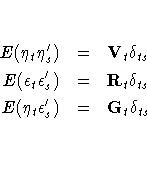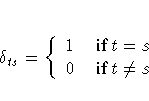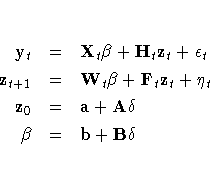| Time Series Analysis and Control Examples |
Kalman Filter Subroutines
This section describes a collection of Kalman filtering and
smoothing subroutines for time series analysis; immediately
following are three examples using Kalman filtering subroutines.
The state space model is a method for
analyzing a wide range of time series models.
When the time series is represented by the state space
model (SSM), the Kalman filter is used for filtering,
prediction, and smoothing of the state vector.
The state space model is composed of the
measurement and transition equations.
The measurement (or observation) equation can be written

where bt is an Ny ×1 vector, Ht is an
Ny ×Nz matrix, the sequence of observation noise
 is independent, zt is an Nz ×1
state vector, and yt is an Ny ×1 observed vector.
is independent, zt is an Nz ×1
state vector, and yt is an Ny ×1 observed vector.
The transition (or state) equation is denoted as
a first-order Markov process of the state vector.

where at is an Nz ×1 vector, Ft
is an Nz ×Nz transition matrix, and the
sequence of transition noise  is independent.
This equation is often called a shifted transition equation
because the state vector is shifted forward one time period.
The transition equation can also be
denoted using an alternative specification
is independent.
This equation is often called a shifted transition equation
because the state vector is shifted forward one time period.
The transition equation can also be
denoted using an alternative specification

There is no real difference between the shifted transition
equation and this alternative equation if the observation
noise and transition equation noise are uncorrelated,
that is,  .
It is assumed that
.
It is assumed that

where

De Jong (1991a) proposed a diffuse Kalman filter that can
handle an arbitrarily large initial state covariance matrix.
The diffuse initial state assumption is
reasonable if you encounter the case of
parameter uncertainty or SSM nonstationarity.
The SSM of the diffuse Kalman filter is written

where  is a random variable with a mean
of
is a random variable with a mean
of  and a variance of
and a variance of  .
When
.
When  , the SSM is said to be diffuse.
, the SSM is said to be diffuse.
The following IML Kalman filter calls are supported:
- KALCVF
- performs covariance filtering and prediction
- KALCVS
- performs fixed-interval smoothing
- KALDFF
- performs diffuse covariance filtering and prediction
- KALDFS
- performs diffuse fixed-interval smoothing
The KALCVF call computes the one-step prediction
 and the filtered estimate
and the filtered estimate  ,
together with their covariance matrices
,
together with their covariance matrices  and
and  , using forward recursions.
You can obtain the k-step prediction
, using forward recursions.
You can obtain the k-step prediction  and
its covariance matrix
and
its covariance matrix  with the KALCVF call.
The KALCVS call uses backward recursions to compute the smoothed
estimate
with the KALCVF call.
The KALCVS call uses backward recursions to compute the smoothed
estimate  and its covariance matrix
and its covariance matrix  when there are T observations in the complete data.
when there are T observations in the complete data.
The KALDFF call produces one-step prediction
of the state and the unobserved random vector
 as well as their covariance matrices.
The KALDFS call computes the smoothed estimate
as well as their covariance matrices.
The KALDFS call computes the smoothed estimate
 and its covariance matrix
and its covariance matrix  .
.
See Chapter 17, "Language Reference," for more information about Kalman filtering
subroutines.
Copyright © 1999 by SAS Institute Inc., Cary, NC, USA. All rights reserved.






![]() as well as their covariance matrices.
The KALDFS call computes the smoothed estimate
as well as their covariance matrices.
The KALDFS call computes the smoothed estimate
![]() and its covariance matrix
and its covariance matrix ![]() .
.